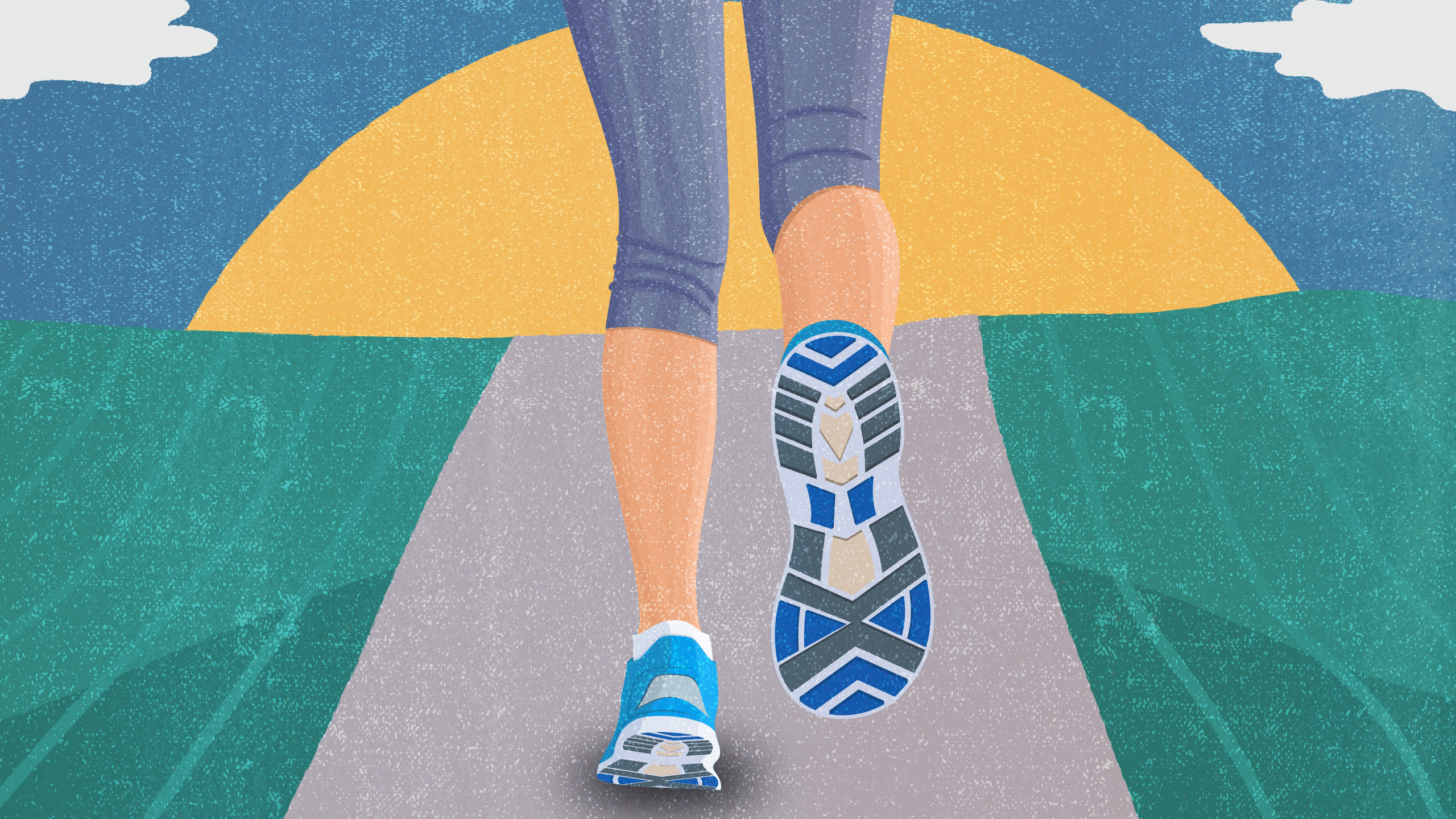
11 Reasons to Take a Daily Morning Walk to Improve Your Health, Focus, and Emotional Regulation
What’s the first thing you do when you wake up in the morning?
If you’re like most people, chances are, you reach for your phone, put the coffee on, and start getting ready for your day. There’s nothing inherently wrong with these morning habits, and you could certainly do worse than making coffee first thing in the morning. However, what if there was an activity you could do when you wake up to get your morning started off on the right foot? We have good news for you — there is! Not only that, but it’s one of the simplest things you can do for exercise.
Walking is one of the best activities you can do for your health. Cardiovascular fitness, bone density, body fat percentage, and muscular strength and endurance can all be improved with as little as 30 minutes of daily walking. Additionally, it can lessen the likelihood that you will develop illnesses such as cardiovascular disease, type 2 diabetes, osteoporosis, and some malignancies.
If you’ve been searching for an easy, healthy way to start each day feeling refreshed and ready to take on anything, look no further! In this article, we provide you with 11 reasons you should take a morning walk and explain all of the benefits that come with it.
Getting Started
Exercise of any kind has been shown to promote health regardless of how strenuous it is or how long it is performed. Walking is a great type of exercise since it is low-impact, convenient, and versatile. A brisk walk is also a great way to get some exercise without exposing yourself to the dangers of more strenuous activities.
Walking for recreation and health doesn’t have to be confined to solo strolls around the block. To incorporate walking as a pleasurable and social element of your life, you can join walking groups, or go to walking events.
Walking a kilometer takes far longer than running the same distance; nonetheless, the quantity of energy expended during each activity is comparable. The main difference is that running uses more oxygen. It may be beneficial to set a daily goal for walking distance and time yourself as you go. However, in order to walk further and use more energy, your fitness level must increase.
Walking quickly burns more kilojoules per hour than walking slowly does, but this does not mean you need to push yourself so hard that you can’t catch your breath in order to see results. Instead, slow down enough to keep a conversation going. By following this general guideline, you can walk without risking your health and still reap the benefits of cardiovascular exercise.
Beginner Tips
Walking gently is the most effective approach to getting warmed up. Walk at a reasonable pace at the beginning of each session so that your muscles have time to warm up, and then ramp up the pace as the session progresses. After that, give your leg muscles a nice, slow stretch, focusing on your calf muscles as well as your front and rear thighs. Holding stretches for approximately twenty seconds is recommended.
Stop stretching as soon as you feel any kind of discomfort. If you bounce or jolt, you risk overstretching the muscle tissue in your body, which can lead to the formation of microscopic tears, which in turn can cause muscle stiffness and soreness.
When engaging in physical exercise, it is best to dress in loose, comfortable clothing. When you dress in a way that is excessively warm, you may find that you sweat more and your body temperature rises, both of which can make walking uncomfortable and may even lead to skin irritations. A slow cool-down will not only prevent injury but will also keep muscles from becoming stiff.
Walking is a method of exercise that is both effective and inexpensive. Nevertheless, foot or shin pain, blisters, and injuries to soft tissue might be brought on by the improper type of shoe or incorrect walking form. Make sure the shoes you wear are comfortable and provide suitable support for your heels and arches. Walk slowly and lightly, making sure that your heel falls to the ground before the rest of your foot. Walking on grass rather than concrete will assist in absorbing some of the impacts of your steps more effectively.
It’s important to keep in mind that our muscles and joints get acclimated to exercising, so if you want to see results, you’ll need to keep pushing yourself to a higher level of exertion as you get fitter.
1. Strengthen Muscles
Walking can be an effective way to improve the muscles in your legs. Make sure to walk at a pace that is somewhere between moderate and brisk to yield the best results. If you’re becoming bored with the same old workout, try walking uphill or downhill, or try a new walking trail. Additionally, squats and lunges, among other leg-strengthening exercises, should be incorporated into your weekly routine multiple times.
2. Improve Mental Acuity
If you want to boost your mental clarity and capacity to focus throughout the day, try going for a walk in the morning. A recent study discovered that, among older persons, those who began their days with a morning walk enhanced their cognitive performance in comparison to those who stayed sedentary. This was the case regardless of whether or not they continued to walk as they became older.
Walking has even been shown to stimulate creative thought in some people. Walking, as opposed to sitting or being sedentary, has been shown in studies to facilitate the free flow of ideas, which can lead to an improved ability to find solutions to problems. This is especially true if you take your walk in the open air. If you have an early morning meeting or brainstorming session coming up, you might want to recommend to your coworkers that they accompany you on a walk if that’s at all possible.
3. Get Better Sleep
Going for a walk first thing in the morning could improve the quality of your sleep later on.
A limited study conducted in 2017 looked at older persons between the ages of 55 and 65 who were having trouble falling asleep at night or were suffering from mild insomnia.
Those who worked out first thing in the morning, as opposed to later in the day, reported having better quality sleep later on. However, in order to determine why working out in the morning may be preferable to working out in the evening for sleep, further research is required. Regardless, the benefits of walking remain.
4. Stay Cool
One of the advantages of going for a walk early in the morning during the summertime — or if you live in an area where the weather is warm all through the year — is that you will be able to get in some exercise before the temperature outside becomes unbearable. Be sure to keep yourself well hydrated by drinking a lot of water both before and after your workout. If you think you might need it, bring a bottle of water with you. You may also make it a point to walk down a path that features water fountains.
5. Improve Decision-Making
It’s possible that going for a walk first thing in the morning will help you make healthier decisions throughout the rest of the day as well as feel less sleep-deprived and more energized. You are much more prone to grab foods that provide you comfort or that give you an energy boost when your energy level is low or when you are fatigued. Walking first thing in the morning could motivate you to make better decisions about what you eat for lunch and snacks later in the day.

Learn The Secrets Of Some Of The Greatest Minds In The World
The Greatness Mindset shows you how to unleash your greatness by clarifying who you are, discovering your Meaningful Mission, and stepping into how you can make an authentic, unique contribution to the world.
Learn More6. Boost Your Energy
If you want to have more energy throughout the day, try going for a walk first thing in the morning — especially if you walk outside. According to a number of studies, people who walked for twenty minutes outside in the fresh air reported higher levels of vitality and energy than those who walked for twenty minutes inside.
In a limited study, it was discovered that for 18 sleep-deprived people, ten minutes of stair walking was much more invigorating than drinking a cup of coffee. If you wake up feeling sleepy or need a burst of energy in the morning, you might want to go for a stroll.
7. Improve Your Mood
Walking first thing in the morning has been shown to have positive psychological effects. Specifically, a walk may aid in increasing your self-esteem, enhance your mood, lower your stress and anxiety levels, reduce your weariness, and either alleviate the symptoms of depression or lower your chance of developing depression. Walking for at least five days a week for a minimum of twenty to thirty minutes will produce the best effects.
8. Get Your Daily Exercise In
One of the advantages of going for a walk first thing in the morning is that it allows you to finish your allotted amount of physical activity for the day before other responsibilities, such as those at work or school, derail you. According to the recommendations laid out in the Physical Activity Guidelines for Americans, persons in good health should engage in at least 150 to 300 minutes worth of exercise per week at a moderate level.
If you want to fulfill these needs, you should give your best effort to walk for thirty minutes five mornings a week.
9. Keep the Weight Off
You may also be able to achieve your desired weight loss by walking first thing in the morning. Walking at a pace that is considered moderate for thirty minutes can burn as much as 150 calories. When combined with a nutritious diet and resistance training, you may find that you are able to shed some pounds.
Join In 200 Million+ On The Journey to Greatness
10. Manage Pre-existing Health Conditions
Walking provides multiple advantages for one’s health, including the enhancement of one’s immune system, as well as the prevention of a variety of health disorders and assistance in their management. According to research, if you walk for thirty minutes every day, you can cut your risk of developing heart disease by nineteen percent.
Walking may also assist you in controlling your blood sugar levels if you are diabetic. It has even been shown to help extend a person’s life span while simultaneously lowering their risk of developing cardiovascular disease and some malignancies.
11. Improve Posture
Many of us spend our work days hunched over a computer or uncomfortably positioned for extended periods of time, hardly even noticing the damage we are doing to our spine and overall posture. If you opt to go for a brisk walk first thing in the morning, you can consciously make an effort to keep your back straight and shoulders back, improving your posture over time. Additionally, walking also improves your core strength, which will also support your spine better.
Start a Great Day with a Great Walk
No one has a perfect routine to achieve optimum health — we all have areas we can improve on. Maybe you already have a healthy morning routine complete with journaling and affirmations, but that doesn’t mean you can’t try going for a walk to see how it affects your day. No matter what, always prioritize your own comfort and happiness above all else, and start small. If a brisk 30-minute walk every day seems like too much at first, start somewhere you’re more comfortable. You’ve got this!
Greatness Authors
Greatness Authors is a collection of writers, thinkers, curiosity experts, and students of the world who are committed to bringing you the most up-to-date, impactful, and inspiring information surrounding Greatness topics.

Do You Have to Be a Morning Person to Be Successful? Here’s What Both Sides Have to Say

9 Reasons You’re Tired All the Time & How to 10x Your Energy

How to Have a Healthy Romantic Relationship Even if You Share Different Beliefs

The 7 Best Vitamins to Naturally Promote Better, Uninterrupted Sleep According to Shawn Stevenson

The Science of Forming Healthy Habits & Letting Go of Bad Ones, According to Author James Clear










